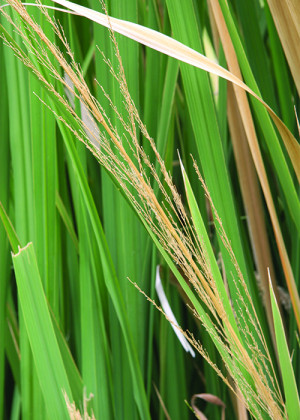 Manchurian wild rice is a very invasive, tall non-native grass that takes over areas of land and shallow water. It has been found in Northland, Auckland, Waikato and Greater Wellington regions, growing next to riparian areas of rivers, lakes and drains, in swamps and on low-lying farmland. In the Waikato region, the main infestations are adjacent to the Waihou and Piako rivers on the Hauraki Plains, and also at Pūriri, Horahora and Lake Te Ko Utu, Cambridge. Manchurian wild rice forms dense mats that keep out other plants and block drainage in waterways.
Manchurian wild rice is a very invasive, tall non-native grass that takes over areas of land and shallow water. It has been found in Northland, Auckland, Waikato and Greater Wellington regions, growing next to riparian areas of rivers, lakes and drains, in swamps and on low-lying farmland. In the Waikato region, the main infestations are adjacent to the Waihou and Piako rivers on the Hauraki Plains, and also at Pūriri, Horahora and Lake Te Ko Utu, Cambridge. Manchurian wild rice forms dense mats that keep out other plants and block drainage in waterways.
Manchurian wild rice has deep roots that can destroy stopbanks. Its root system spreads widely, and any fragment can grow into a new plant. Manchurian wild rice destroys native plant and fish habitats.
What does it look like?
A dense, mat-forming perennial grass up to 4 metres in height with rhizomes (2-3 centimetres in diameter and up to 5 metres long) and fibrous roots.
Flower

|

|
- Purplish or red-brown flower heads half a metre long can appear from about October to December.
Leaves/stems

|

|
- Harsh, papery, dull grey-green leaves (2-3 centimetres wide) are straight, up to 2.5 metres long, have a stout midrib and usually taper to a point.
Similar plants
Manchurian wild rice looks very much like two of our native species: raupō (bullrush) and harakeke (flax). However, raupō does not remain green over winter, or have an obvious midrib like Manchurian wild rice does, while the leaves of harakeke are much wider, thicker and shinier than Manchurian wild rice.
Why is it a pest?
Manchurian wild rice is a highly invasive grass that forms dense long-lived stands on land and water margins, overtopping other riparian species. Causes silt to accumulate, altering water systems, leading to flooding and destroying habitat for aquatic fauna and flora. Manchurian wild rice has deep roots that can destroy stopbanks. Its root system spreads widely, and any fragment can grow into a new plant.
How does it spread?
Rhizomes spread outwards slowly, but more rapid spread comes from seeds and rhizome fragments being moved by water, livestock, machinery, clothing and possibly by birds. Road graders, soil movement, dumped vegetation, contaminated diggers, farm machinery, eel nets, boats and trailers all spread seed and rhizome fragments into new catchments, lowland pasture, roadsides, water tables, drains and farm dams.
More information
Advice
- For additional information and advice on Manchurian wild rice, call our pest plant staff on freephone 0800 800 401.
Publications
- The following publications are available online.



